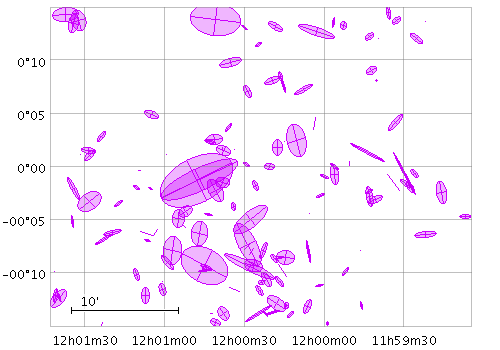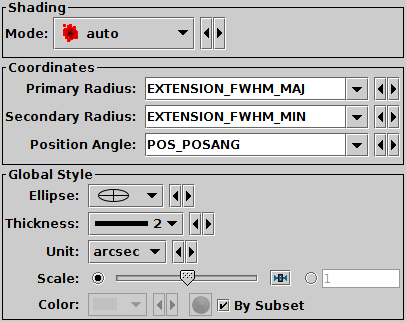Next Previous Up Contents
Next: XYCorr Form
Up: Plot Forms
Previous: XYEllipse Form
The SkyEllipse ( ) form
plots an ellipse (or rectangle, triangle, or other similar figure)
defined by two principal radii and an optional angle of rotation,
the so-called position angle.
This angle, if specified, is in degrees and gives the angle
from the North pole towards the direction of increasing longitude
on the longitude axis.
) form
plots an ellipse (or rectangle, triangle, or other similar figure)
defined by two principal radii and an optional angle of rotation,
the so-called position angle.
This angle, if specified, is in degrees and gives the angle
from the North pole towards the direction of increasing longitude
on the longitude axis.

Example SkyEllipse plot

SkyEllipse form configuration panel
The configuration options are:
-
Primary Radius, Secondary Radius
- The two principal radii for the ellipse.
If auto-scaling is off, these are in units of degrees.
It doesn't matter whether the primary is larger than the secondary.
If the Secondary Radius field is left blank, it is assumed to equal
the Primary Radius field, i.e. the ellipses are circles.
-
Position Angle
- Orientation of the ellipse. This is the angle in degrees
from the North pole to the primary axis of the ellipse in the
direction of increasing longitude.
If the value is missing (either this field not filled in or blank in
the data) it is considered to be zero.
-
Ellipse
- Ellipse graphical representation, selected from a range of options
(includes also rectangles, crosses etc).
-
Thickness
- Controls the line thickness used when drawing ellipses.
Zero, the default value, means a 1-pixel-wide line is used.
Larger values make drawn lines thicker, but note changing
this value will not affect all shapes, for instance filled
ellipses contain no line drawings.
-
Scale
- Changes the factor by which all ellipse sizes are scaled.
If the ellipses are too small, slide it right, if they are too big,
slide it left. The slider scale is logarithmic.
Alternatively, enter a fixed value in the text field.
-
Auto Scale
- If selected, this option will determine the default ellipse scale size
from the data - it will fix it so that the largest ellipses are a few
tens of pixels long by default.
That scaling can then be adjusted using the Scale slider.
If unselected, then the default position of the Scale slider corresponds
to the actual values in degrees given by the submitted ellipse
radii coordinates.
Next Previous Up Contents
Next: XYCorr Form
Up: Plot Forms
Previous: XYEllipse Form
TOPCAT - Tool for OPerations on Catalogues And Tables
Starlink User Note253
TOPCAT web page:
http://www.starlink.ac.uk/topcat/
Author email:
m.b.taylor@bristol.ac.uk
Mailing list:
topcat-user@jiscmail.ac.uk
![]() ) form
plots an ellipse (or rectangle, triangle, or other similar figure)
defined by two principal radii and an optional angle of rotation,
the so-called position angle.
This angle, if specified, is in degrees and gives the angle
from the North pole towards the direction of increasing longitude
on the longitude axis.
) form
plots an ellipse (or rectangle, triangle, or other similar figure)
defined by two principal radii and an optional angle of rotation,
the so-called position angle.
This angle, if specified, is in degrees and gives the angle
from the North pole towards the direction of increasing longitude
on the longitude axis.

